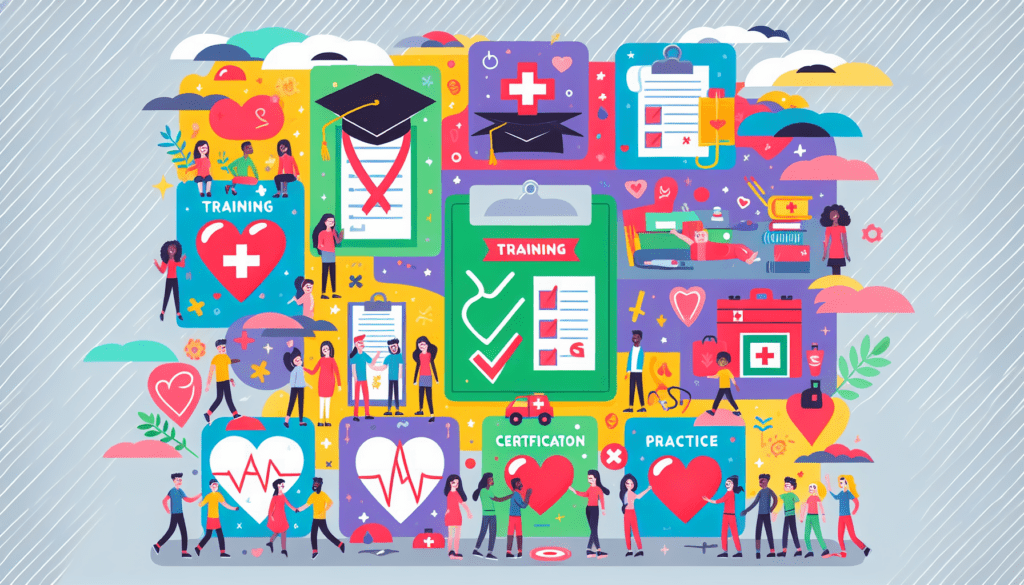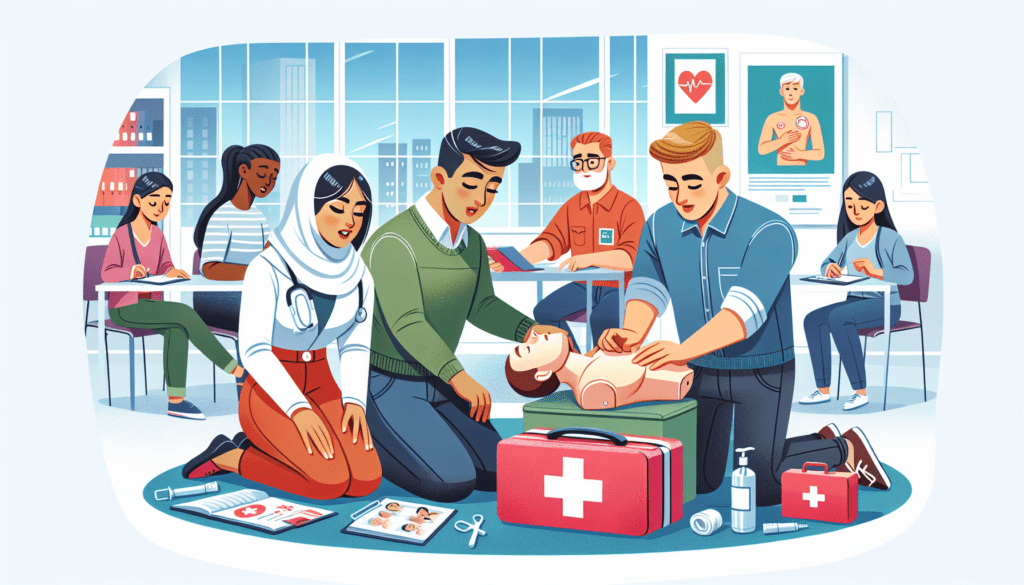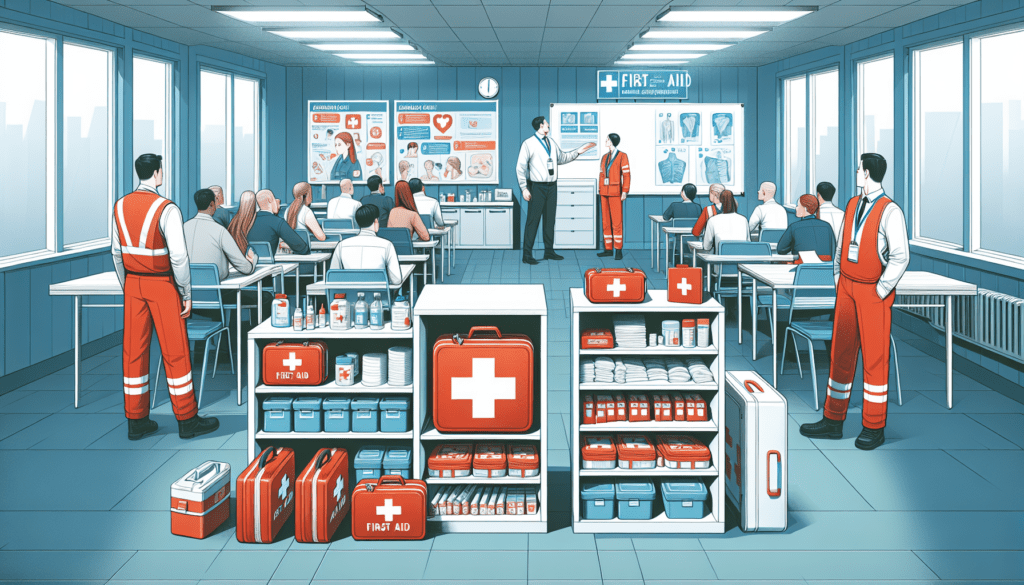Curious about how to become a first aider? This guide will walk you through the essential steps. You’ll learn what the role involves, how to choose the right first aid courses and the process of maintaining your certification. Get ready to make a difference!
Key Takeaways
- First aiders play a crucial role in providing immediate assistance to casualties during emergencies, requiring proper training and assessment of situations.
- Individuals must complete certified first aid courses to become qualified first aiders, which should be regularly updated to maintain certification.
- Choosing the right first aid training provider is essential for quality instruction, with various courses available tailored to different environments and emergency needs.
Understanding the Role of a First Aider

An individual becomes a first aider after successfully completing a work course in first aid and passing the necessary final evaluation. Such individuals are instrumental during emergencies as they offer prompt support to those who have been injured. The capabilities of first aiders not only contribute to saving lives but also mitigate injuries and enhance the prognosis for victims. To ensure safety before proceeding, the hospital’s fundamental responsibility is to provide immediate healthcare intervention when an emergency arises.
In carrying out their duties, it’s crucial that first aiders engage effectively with both the injured party and onlookers, maintaining clear communication about what is occurring and which measures are being taken. They hold the obligation of observing changes in the condition of casualties until medical professionals take over care provision. Their tasks frequently involve judging potential hazards and ensuring nobody—they themselves or others—is put at risk from infection while calling for additional assistance if needed.
To handle various potential crises effectively, offering suitable assistance requires undergoing appropriate training predicated on assessments specific to workplace conditions regarding needs related to first aid.
While performing this role comes with certain liabilities should incidents occur under their watch, facing legal repercussions remains rare, provided that actions by these trained responders adhere closely to what has been taught within their training parameters.
Nevertheless, seeking clarification from employers regarding liability protection or obtaining independent legal counsel is recommended, especially where there isn’t direct employment involved.
Steps to Becoming a First Aider

Acquiring the qualifications to become a first aider entails adopting an appropriate mindset, displaying proper conduct, and mastering the necessary skills. Participation in a first aid course serves as the foundational step toward equipping oneself with crucial abilities for addressing emergencies effectively. Such courses include but are not limited to Level 3 Emergency First Aid at Work or Level 3 Award in Paediatric First Aid, both of which are instrumental in achieving a recognised first aid qualification.
To administer effective emergency first aid, adequate training is imperative. Prospective participants must possess an elementary proficiency in English (level 2) to partake in these aid courses. The curriculum spans various subjects ranging from evaluating emergent conditions to delivering immediate assistance efficiently. Completion of such training empowers individuals with the official status of qualified first aider—adept at responding swiftly and potentially saving lives during critical incidents.
Embracing the role of a workplace first aider transcends merely finishing workplace-specific training courses. It’s about cultivating readiness to confront real-world emergencies assuredly and proficiently. Commitment to ongoing learning ensures your preparedness remains sharp so you can offer timely life-saving assistance when circumstances demand rapid action.
Choosing the Right First Aid Training Courses
Choosing the appropriate first aid training course is essential to equip yourself adequately for potential emergency situations. Evaluating personal requirements is fundamental in identifying which first aid courses best correspond with your duties and the nature of emergencies you could potentially face. Various tailored options exist among these courses, catering to distinct scenarios and demographic needs.
Prior to exploring individual course specifics, it’s vital to recognise what constitutes a reliable training provider. The hallmarks of an esteemed provider include proper accreditation and a commendable track record that guarantees high-quality teaching.
Subsequent sections will delve deeper into available varieties of first aid training programs as well as outline selection criteria for distinguishing trustworthy providers in this domain.
Types of First Aid Courses
A multitude of first aid training programs exist, tailored to cater to distinct requirements and settings. The Emergency First Aid at Work is a concise one-day work course suited for lower-risk settings like offices, focusing on the evaluation and response to emergencies such as instances of choking or hemorrhage. Conversely, for more hazard-prone environments, the extensive three-day First Aid at Work course delves into an array of injuries and maladies that could manifest in a workplace.
Tailored toward individuals who look after children—such as parents and guardians involved in childcare roles—and professionals dedicated to child safety measures. Paediatric First Aid courses emphasise addressing the specific medical needs young children might face. Standardised first aid courses impart practical skills necessary to support people during varied emergency scenarios—from assessing casualties through managing lacerations efficiently up to proficiently deploying defibrillators.
Entities, including the British Red Cross, have curated specialised training programs aimed squarely at meeting particular necessity profiles, so enrollees are adeptly equipped when faced with real-world crises they may encounter. Irrespective of whether your pursuit involves acquiring a foundational knowledge set or you require more nuanced expertise within this domain, there is an appropriate range of first aid courses available.
Selecting a Training Provider
It is crucial to evaluate the credentials and expertise of instructors when choosing a provider for first aid training. Opt for a trusted training provider that delivers adaptable educational solutions, catering to varied learning styles and timetables. This guarantees you acquire a superior education tailored to your requirements.
Search for providers renowned for their excellence with affirmative feedback from former attendees. Such endorsements can bolster your trust in the calibre of the aid training they offer.
Selecting an appropriate training provider ensures that you are fully equipped with the necessary skills to manage urgent situations and administer proficient first aid effectively.
Essential Skills for First Aiders

Possessing a specialised skill set is indispensable for first aiders, extending well beyond fundamental aid training. Rapid decision-making abilities are critical, as they equip first aiders to evaluate emergency situations and act without hesitation. It’s also imperative that they communicate effectively with emergency services to convey precise details needed for proper assistance.
For a first aider to perform efficiently under the stress of an emergent event, maintaining composure and displaying confidence are key attributes. They must exhibit leadership qualities and be adept at teamwork since orchestrating collective efforts during crises can be necessary. It is vital for qualified first aiders to deliver immediate relief from pain for those who have incurred injuries.
When armed with extensive training, these individuals are aptly ready to confront emergencies across a spectrum of scenarios. Continual enhancement of their skills empowers them to provide crucial support and play their part in life-saving endeavours.
Certification and Recertification Process
It’s essential to keep your first aid skills and qualifications up-to-date. Regular refreshers in first aid training are necessary to maintain a high level of preparedness and compliance. If you’re required to renew your abilities in providing aid, enrolling in a requalification course is crucial for updating your certification, which holds its validity for three years.
Below, we will explore the details involved with acquiring and preserving your first aid certificate, including engaging in continuous refresher courses and undergoing requalifications when needed.
Obtaining Your First Aid Certificate
Securing a first aid qualification requires successful participation and completion of an accredited first aid course. This comprehensive training spans various emergency situations, equipping participants with the necessary skills in providing immediate assistance. The validity of a first aid certificate stretches over three years, after which one must requalify to maintain their status.
Upon accomplishing these steps, individuals are acknowledged as qualified first aiders who are prepared to offer prompt support during emergencies.
Maintaining Your Certification
It’s critical for individuals certified in first aid to participate in yearly refresher training courses, ensuring that their proficiency is current and effective. Prior to the expiration of their certification, first aiders are required to complete a two-day requalification course. This commitment keeps them compliant and prepared to deliver competent aid.
To ensure continuous certification and avoid any gaps, it’s important to schedule your requalification ahead of time. Regularly attending these trainings sustains the confidence necessary for first aiders to efficiently manage emergency situations whenever they may arise.
Workplace First Aid Requirements

The obligation falls on employers to ensure that they have satisfactory first aid provisions tailored to the particular requirements of their workplace setting. This duty is part of a broader commitment under health and safety legislation aimed at safeguarding employee well-being within all work environments, while also preserving an organisation’s standing.
To identify the exact number of trained first aiders needed or if merely an appointed person should be in place for managing basic emergency measures, it is crucial for employers to conduct ongoing risk evaluations pertinent to their unique operational context. It becomes mandatory when specific hazards inherent in the working environment are identified that may necessitate immediate health interventions.
In keeping with directives from the Health and Safety Executive, providing appropriate equipment like first-aid kits or eye-wash stations goes hand-in-hand with establishing explicit protocols for dealing with emergencies. Ensuring these measures are implemented effectively contributes significantly towards fostering a secure workspace where employees can operate without undue risks.
Benefits of Being a Qualified First Aider

Gaining qualification as a first aider brings both personal and career advancements. It unlocks job prospects, particularly in sectors such as security, where having certified individuals is mandatory. Those who are qualified to provide aid possess traits of calmness and positivity, which are essential for alleviating their stress while comforting those affected.
Prompt and proficient delivery of first aid can dramatically shorten the duration needed for someone’s recuperation, expediting their ability to resume work activities and even playing a vital role in preserving lives. Becoming a first aider boosts not just one’s professional value, but also fosters individual development and equips them with the capabilities to make meaningful contributions during emergency scenarios.
Summary
To summarise, embarking on the journey to becoming a first aider means recognising the vital importance of their role, undergoing requisite aid training, and keeping your certification up-to-date. Those qualified in first aid are indispensable for providing prompt assistance that can save lives and foster safety within the workplace. Acquiring status as a skilled first aider brings personal enrichment and a substantial impact during critical situations.
It is our aspiration that this guide has elucidated the path toward becoming an adept first aider for you. Engaging in diligent first aid training and consistently honing these abilities ensures readiness to confront emergency scenarios and deliver crucial support when required most urgently.
Frequently Asked Questions
Do first aiders get paid?
Whether first aiders receive extra pay is contingent upon company policy and individual contracts, so it’s best to check with your employer.
Engaging in this role offers valuable skills and benefits beyond financial compensation.
What is the primary role of a first aider?
A first aider’s chief responsibility involves promptly attending to individuals who have sustained injuries, securing their well-being and enhancing the likelihood of recovery by offering assistance before trained medical professionals take over.
What courses are necessary to become a qualified first aider?
To be recognised as a qualified first aider, it is essential to finish either the Level 3 Emergency First Aid at Work course or the Level 3 Award in Paediatric First Aid.
It is vital to obtain proper training in order to respond efficiently during an emergency.
How often do I need to requalify as a first aider?
You need to requalify as a first aider every three years by attending a two-day refresher course.
This ensures your skills remain up-to-date and effective.
What should I consider when choosing a first-aid training provider?
Choose a first-aid training provider with proper accreditation, qualified instructors, and flexible learning options to ensure a quality training experience.
These factors will enhance your confidence and preparedness in emergency situations.


